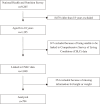Socioeconomic Status and Overweight: A Population-Based Cross-Sectional Study of Japanese Children and Adolescents
- PMID: 26005066
- PMCID: PMC4483371
- DOI: 10.2188/jea.JE20140108
Socioeconomic Status and Overweight: A Population-Based Cross-Sectional Study of Japanese Children and Adolescents
Abstract
Background: Socioeconomic status (SES) as a determinant of obesity has received scant attention in Japan. This study examined the association between SES and overweight among Japanese children and adolescents.
Methods: Cross-sectional analyses of a representative sample of Japanese children (6-11 years: n = 397) and adolescents (12-18 years: n = 397) were performed, with measured heights and weights from the 2010 National Health and Nutrition Examination Survey and the 2010 Comprehensive Survey of Living Conditions. Overweight, including obesity, was defined by International Obesity Task Force cut-offs. SES indicators included household income, equivalent household expenditure, parental educational attainment, and parental occupational class.
Results: Overweight prevalence was 12.3% in children and 9.1% in adolescents. Adolescents living in middle-income households were more likely to be overweight than those living in high-income households (OR 2.26, 95% CI, 1.01-5.67) after adjustment for age, sex, and parental weight status. Similarly, adolescents living in households with low expenditure levels were more likely to be overweight than those living in households with high expenditure levels (OR 3.40, 95% CI, 1.20-9.60). In contrast, no significant association was observed among children.
Conclusions: Our results indicated that low household economic status was associated with being overweight, independent of parental weight status, among Japanese adolescents.
Figures
Comment in
-
Epidemiologic Study on Social Determinants of Health: What's Next?J Epidemiol. 2015;25(7):461-2. doi: 10.2188/jea.JE20150082. Epub 2015 May 23. J Epidemiol. 2015. PMID: 26005068 Free PMC article. No abstract available.
Similar articles
-
Socioeconomic disparities in psychological distress in a nationally representative sample of Japanese adolescents: A time trend study.Aust N Z J Psychiatry. 2017 Mar;51(3):278-286. doi: 10.1177/0004867416664142. Epub 2016 Sep 29. Aust N Z J Psychiatry. 2017. PMID: 27553359
-
Disparities in childhood overweight and obesity by income in the United States: an epidemiological examination using three nationally representative datasets.Int J Obes (Lond). 2019 Jun;43(6):1210-1222. doi: 10.1038/s41366-019-0331-2. Epub 2019 Feb 4. Int J Obes (Lond). 2019. PMID: 30718822 Free PMC article.
-
Relationship Between Socioeconomic Status and the Prevalence of Underweight, Overweight or Obesity in a General Japanese Population: NIPPON DATA2010.J Epidemiol. 2018;28 Suppl 3(Suppl 3):S10-S16. doi: 10.2188/jea.JE20170249. J Epidemiol. 2018. PMID: 29503379 Free PMC article.
-
Prevalence of malnutrition among children and women of reproductive age in Uruguay by socio-economic status and educational level.Public Health Nutr. 2020 Aug;23(S1):s101-s107. doi: 10.1017/S1368980020000804. Epub 2020 Apr 17. Public Health Nutr. 2020. PMID: 32299530 Free PMC article. Review.
-
The socioeconomic gradient in overweight and obesity among Colombian adult and pediatric populations: A scoping review.Nutr Health. 2024 Sep;30(3):463-477. doi: 10.1177/02601060241248307. Epub 2024 Apr 23. Nutr Health. 2024. PMID: 38651331
Cited by
-
Subjective Household Economic Status and Obesity in Toddlers: A Cross-Sectional Study of Daycare Centers in Japan.J Epidemiol. 2019 Jan 5;29(1):33-37. doi: 10.2188/jea.JE20170081. Epub 2018 Jun 9. J Epidemiol. 2019. PMID: 29887543 Free PMC article.
-
Short Sleep Duration is Inversely Associated with the Prevalence of Underweight in a Young Japanese Population.Nat Sci Sleep. 2025 Jun 23;17:1459-1466. doi: 10.2147/NSS.S519501. eCollection 2025. Nat Sci Sleep. 2025. PMID: 40584287 Free PMC article.
-
Household income is associated with food and nutrient intake in Japanese schoolchildren, especially on days without school lunch.Public Health Nutr. 2017 Nov;20(16):2946-2958. doi: 10.1017/S1368980017001100. Epub 2017 Aug 30. Public Health Nutr. 2017. PMID: 28851478 Free PMC article.
-
Exploring an Applied Ecological Model of the Effects of Household, School, and Community Environments on Adolescent Mental Health in Japan.Int J Environ Res Public Health. 2022 Dec 14;19(24):16820. doi: 10.3390/ijerph192416820. Int J Environ Res Public Health. 2022. PMID: 36554701 Free PMC article.
-
Changes in overweight/obesity and central obesity status from preadolescence to adolescence: a longitudinal study among schoolchildren in Japan.BMC Public Health. 2020 Feb 17;20(1):241. doi: 10.1186/s12889-020-8343-3. BMC Public Health. 2020. PMID: 32066409 Free PMC article.
References
-
- Ministry of Education, Culture, Sports, Science and Technology. A report of school health statistics. Tokyo: National Printing Bureau; 2010.


